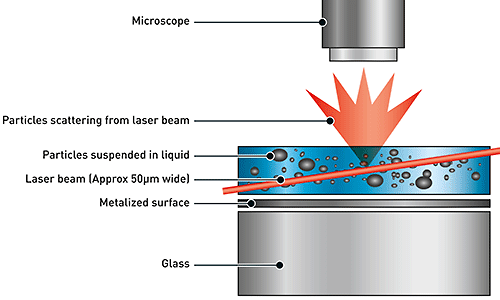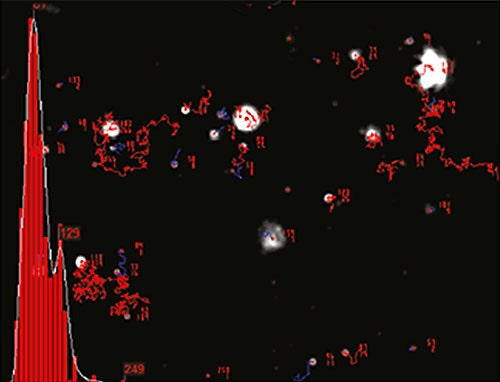Nanocarbon production and research has increased in recent years for both graphite and diamond forms. Here, we discuss examples where Nanoparticle Tracking Analysis is helping to understand and characterizae these carbon-based nanostructures.
Nanocarbon production and research has increased in recent years for both graphite and diamond forms. Potential uses of nanocarbon graphite include bio-nano applications, polymers, textiles and fuel cells, while it is reported that nanodiamond has been used for drug delivery applications, dry and oil lubricants and polishing. Carbon nanotubes, as the name suggests, are cylinders of carbon atoms, a few nm in diameter but with a length than can be up to several million times the diameter. Formed of graphene sheets, these structures have useful electrical, thermal, mechanical and tensile properties, and are proposed in numerous applications including electrical circuits, solar cells, super capacitors, environmental contaminant removal, and medical diagnostics.
This white paper discusses examples where Nanoparticle Tracking Analysis is helping to understand these carbon-based nanostructures.
NTA utilizes the properties of both light scattering and Brownian motion in order to obtain the particle size distribution of samples in liquid suspension. A laser beam is passed through the sample chamber, and the particles in suspension in the path of this beam scatter light in such a manner that they can easily be visualized via a 20x magnification microscope onto which is mounted a camera. The camera, which operates at approximately 30 frames per second (fps), captures a video file of the particles moving under Brownian motion within the field of view of approximately 100 μm x 80 μm x 10 μm (Figure 1).

|
The movement of the particles is captured on a frame-by-frame basis. The proprietary NTA software simultaneously identifies and tracks the center of each of the observed particles, and determines the average distance moved by each particle in the x and y planes. This value allows the particle diffusion coefficient (Dt) to be determined from which, if the sample temperature T and solvent viscosity η are known, the sphere-equivalent hydrodynamic diameter, d, of the particles can be identified using the Stokes-Einstein equation (Equation 1).

|
where KB is Boltzmann’s constant.
NTA is not an ensemble technique interrogating a very large number of particles, but rather each particle is sized individually, irrespective of the others. An example of the size distribution profile generated by NTA is shown in Figure 2.

|
In addition, the particles’ movement is measured within a fixed field of view (approximately 100 μm by 80 μm) illuminated by a beam approximately 10 μm in depth. These figures allow a scattering volume of the sample to be estimated; by measuring concentration of the particles within this field of view and extrapolating to a larger volume it is possible to achieve a concentration estimation in terms of particles per mL for any given size class or an overall total.
Following earlier and preliminary used of NTA to characterize various carbonaceous nanomaterials such as carbon nanotube-nematic liquid crystal composite materials (Trushkevych et al., 2007 and 2008) and the oxidative potential of a panel of carbonaceous and metallic nanoparticles (Hohl et al., 2009), more recent work using NTA has focused on carbon nanotubes and nanocolloids.
To assess the removal efficiency of formaldehyde using nano-size carbon colloid, which was produced by a comparatively easy and cheap method, Kim et al. (2011) produced nano-size carbon colloid based on water by an electro-chemical method. NTA was used to monitor carbon particle size in production. Lv et al. (2011) used NTA to determine the size of graphene oxide nanoparticles in the design and production of graphene oxide membranes for possible use in new optical devices.
In the case of carbon nanotubes (CNTs), despite their highly asymmetric shape, NTA has been used to determine the sphere equivalent diameter as an indicator of sample monodispersity and behavior in different matrices. Thus, Schwyzer et al. (2011) have studied the influence of the initial state of carbon nanotubes on their colloidal stability under natural conditions over a period of many days. They showed that the initial state of the CNTs (dry vs. suspended) and the medium composition are critical determinants for the partitioning of CNTs between sediment and the water column. This work was subsequently extended into a more extended study on the long-term colloidal stability of 10 carbon nanotube types in the absence/presence of humic acid and calcium.
Recently, Zemanova has investigated the cytotoxicity of a water-soluble, radioprotective C60 fullerene derivative (DF) which had been obtained by a reaction of C60 fullerene with peracetic acid and subsequent hydrolysis. She used NTA to show that monodisperse DF was less cytotoxic to cell cultures than an unfiltered, polydisperse equivalent which coagulated on cell surfaces (Zemanova et al., 2011). Clements (2013) has shown that while DLS data for a sample of a C60 colloids indicated a bimodal distribution and that the larger particles detected by DLS are beyond the range of the NTA instrument, the NTA particle size distribution for this sample picked up mainly the particles slightly larger than 100 nm. The mode of the NTA particle size distribution for C60 agreed quite well with the number distribution data given by DLS.
The cellular toxicity of C60 fullerenes in RAW 264.7 immortalized macrophages has been studied by Russ (2013) and showed that exposure of immune cells to C60 fullerenes results in uptake of the nanoparticles and alterations in the normal functions of the cell. NTA was used to analyze the size of C60 Fullerene and terbium endohedral Fullerene aggregates.
In a study of the photoacoustic contrast imaging of biological tissues with radiation-damaged nanodiamonds fabricated for high near-infrared absorbance, Zhang et al. (2013) used NTA to carry out size determinations.
Reed et al. (2013) used single particle-inductively coupled plasma-mass spectrometry (spICPMS) to detect single walled carbon nanotubes by monitoring embedded metals using trace catalytic metals intercalated in the CNT structure as proxies for the nanotubes. Interestingly, analysis of split samples by both spICPMS and NTA showed the quantification of particle number concentration by spICPMS to be several orders of magnitude lower than by NTA. They postulated that this was a consequence of metal content and/or size, caused by the presence of many CNTs that do not contain enough metal to be above the instrument detection limit, resulting in undercounting CNTs by spICPMS. However, they claimed that since the detection of CNTs at low ng L-1 concentrations is not possible by other techniques, spICPMS was still a more sensitive technique for detecting the presence of CNTs in environmental, materials, or biological applications. In a recent patent filing Fahmy et al. (2013) have described carbon nanotube-based compositions for activating cellular immune responses supporting their claims with NTA data on analysis of their magnetite and CL-2 loaded PLGA nanoparticles.
Finally, Sun et al. (2013) have investigated the adsorption of size-selected Pt colloidal nanoparticles on high-surface-area graphene powders for methanol oxidation reaction given graphene-supported nanoparticles are of tremendous interest for a variety of applications recently. They found that the adsorption of Pt colloidal nanoparticles on graphene surfaces is dramatically influenced by the process parameter in the mixing process and, specifically, the different solution volumes during the mixing process result in various catalyst morphologies.
Most recently, Chen et al. (2013) have used NTA to characterize the interactions between protein and carbon black (CB) in which they revealed that the CB can react with proteins (55 kDa and 70 kDa) after inhalation and may modify the functional structures of lung proteins, leading to the activation of acute-inflammatory responses in the lungs.